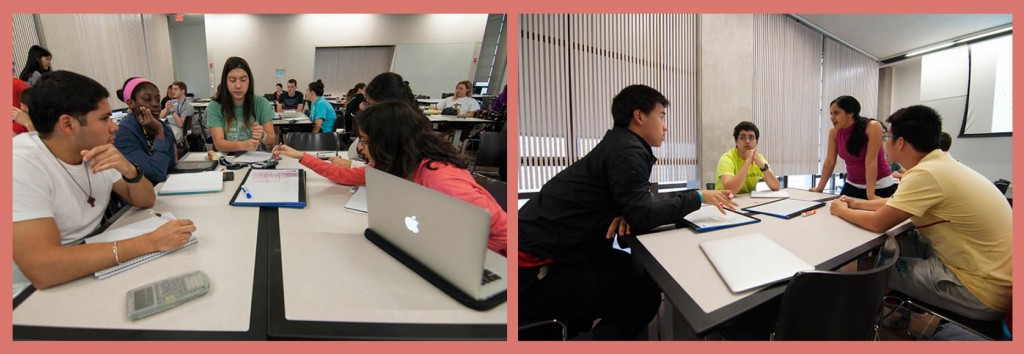Since the fall 2012 semester, Dr. Lesa Tran joined forces with Professor John Hutchinson and Dr. Kristi Kincaid to implement the SCAL@R (Student-Centered Active Learning at Rice) approach in CHEM 121/122: General Chemistry, making “GenChem” the largest service course at Rice to use this unusual teaching model, with approximately 400 students enrolled every year.
Tran, Wiess Instructor of Chemistry, received her Ph.D. from Rice in the spring of 2012 and was recruited to teach the following semester. Her first priority was to take the GenChem curriculum taught by Hutchinson, who has historically taught chemistry using a constructivist approach, and convert it into the SCAL@R model.
According to Tran, the goal of the SCAL@R approach is to optimize the classroom experience so as to actively engage students in constructing and reinforcing their own knowledge base. “It’s kind of like sports: that the more you practice, the better you’ll do at it. However, practicing on your own only gets you so far. You have to have someone to practice with you to improve. The same thing goes in a classroom: to optimize your learning experience in class and to better retain the concepts taught in class, you should be interacting with your classmates, TAs, and instructors to learn and discuss the material together.”

A touch screen monitor runs the room’s projection system, which Tran uses for writing on Powerpoint slides as well as using an audience response system, which can indicate how well the students understand the material.
GenChem is currently taught in three sections using Brockman 101, a SCAL@R-configured classroom, which accommodates up to 150 students. Modeling the constructivist approach, the instructor spends the first few minutes of a typical GenChem class setting up a premise, after which the students break into smaller groups to discuss questions that are designed to help them lead themselves into learning a concept or developing a model from data. The instructor and undergraduate and graduate teaching assistants circulate around the room offering guidance to the student groups. After most of the groups understand the material, the instructor reconvenes the large group to review and summarize new concepts using Socratic dialogue. Then the instructor introduces the next topic, often building on the previous information, and the process repeats itself again. Tran explains, “My objective is to actively engage the students as much as possible to get them to do work, to talk to each other and to foster this idea that they shouldn’t be afraid to ask for help, which is a very difficult thing to do as a freshman.” Crediting her colleagues, Tran said, “I couldn’t possibly do this without Dean Hutch, Dr. Kincaid, and our TAs.”
Skipping ahead to spring semester 2015, Tran discussed some of the ways the GenChem teaching team adapted the SCAL@R method with input from students over the last three years. Students originally had been in groups of nine but later reduced to six. “It’s like a dinner party, if you are seated at a table of nine, it is harder for you to have a discussion with the person across the table from you than if you are seated at a table of six.” They also varied the length of time students remain in a specific group. Originally groups changed every day and then they tried every week, but they realized it takes a while for the students to become really comfortable with each other so they decided to keep groups together for longer periods, and now groups are shuffled after every unit exam.
This year the format was changed to have fewer, but longer, SCAL@R activities. Previously group activities were five to seven minutes long with each session requiring activation time for each group to get started, especially in the fall semester as students became used to engaging in discussions. Consolidating the material into longer activities of 7-10 minutes reduced the number of group sessions and made the class more efficient.
Kincaid runs the lab component of the course using the SCAL@R format as well. Since spring 2012, the number of experiments for each semester has been reduced so that more instruction time can be devoted to discussing results and analyzing data. In the week following an experiment, the 48 lab students break into smaller groups for SCAL@R-style discussion sections. In these, they analyze their experimental results and work on TA-led exercises that help them complete their lab reports and also directly relate their experiment to the material covered in lecture.
Tran summarizes, “SCAL@R is not only effective for teaching the subject but helps them round themselves out and improve themselves as students and thinkers.” She enjoys watching students grow and being part of the mentoring process. “Not all students will go on to become scientists, but they’ll think more like one. They’ll learn to think critically, assess information, and not just blindly accept it – and that’s essential for succeeding in any profession.”

Brockman 101 is the SCAL@R classroom for GenChem designed as a large space to accommodate tables for small group discussions and problem solving. Tran and Hutchinson presented about SCAL@R at Rice’s Center for Teaching Excellence’s Teaching and Learning Symposium on January 15, 2015. Watch a recording of their teaching demonstration at http://cte.rice.edu/symposium.

